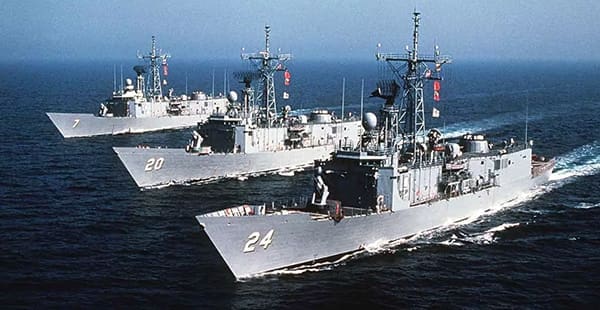History of Frigates
Frigates have played an important role in U.S. naval history since the Navy began. In the late 1700s, the Navy used three main types of warships: frigates, ships-of-the-line and sloops-of-war. The frigate was the second largest. It escorted other vessels, patrolled coastlines and sometimes took part in combat.
In 1775, the Revolutionary War began, and Congress ordered the creation of a new Navy. As part of this effort, they approved the construction of 13 strong, well-armed frigates. But these new ships faced a serious challenge. The British Navy was larger, better trained and better equipped.
Even so, ships like USS Boston and USS Hancock captured enemies and joined key battles. Another frigate, the USS Alfred, became the Navy’s first flagship and the first to raise the “Flag of Freedom.”
After the Revolutionary War, the Navy was nearly disbanded. By 1785, the last remaining frigate, the USS Alliance, was sold. But growing threats at sea led Congress to act again. In 1794, the Navy approved six new frigates. The first was the USS United States.
Frigates evolved through the 1800s as steam replaced sails. Launched in 1843, the USS Michigan was the Navy’s first iron-hulled warship. Other steam-powered ships, like USS Fulton, followed.
During World War II (WWII), the British Navy revived the term “frigate” for ships used in convoy escort and antisubmarine roles. The U.S. Navy used the term “destroyer escort” instead, though the missions were similar. In 1975, the U.S. officially adopted the term “frigate” to match NATO standards. That same year, it began building Oliver Hazard Perry-class frigates and constructed 51 by 1989.
Many naval vessels built or repaired between 1940 and 1980 used asbestos, especially in boiler rooms and engine spaces. Sailors working in these areas may have been exposed to airborne fibers. Over time, this kind of exposure could lead to mesothelioma or other related diseases.
Frigates remain a vital part of the modern U.S. Navy. The new Constellation-class frigates are now under construction. They feature advanced radar, upgraded engines and better missile defense.
The USS Constellation is the first ship of this class and had its keel laid in 2024. Others are progressing through early construction stages. Once finished, they will help with defending coastlines, escorting ships and patrolling the seas.
Frigates’ History at a Glance
- Other Names/Classes: Bronstein (FF), Brooke (FFG), Constellation, Garcia (FF), Glover (AGFF), Knox (FF), Oliver Hazard Perry (FFG), Tacoma
- Years of Operation: 1797 – Present
- Wartime Operations: Barbary Wars, Cold War, Korean War, Quasi-War, Revolutionary War, War of 1812, World War II (WWII)
- Size of Crew: Roughly 200 people
- Size of Ship: 175 feet long and 40 feet wide – 496 feet long and 65 feet wide
- Noteworthy Ships: USS Gloucester, USS Oliver Hazard Perry, USS Sausalito, USS Tacoma
Notable Frigates
Some U.S. Navy frigates are known for their combat roles and long service. Early ships like the USS Constitution and USS United States helped shape the Navy’s history. But the frigates linked to asbestos exposure served much later.
Ships like the USS Gloucester, USS Sausalito and USS Tacoma served during the Korean War. These frigates operated under tough conditions. Many were built or repaired at a time when asbestos use was widespread.
The material was often found in high-heat areas, like boiler rooms and engine spaces. Sailors and shipyard workers may have been exposed to fibers during repairs or daily tasks. Over time, this kind of exposure may lead to mesothelioma, lung cancer or asbestosis.
USS Sausalito (PF‑4)
The USS Sausalito was a Tacoma-class frigate built in Richmond, California, and launched in July 1943. It served as an escort vessel in Alaska during World War II. In 1945, the U.S. transferred the ship to the Soviet Navy under a secret lend-lease program. It returned to the U.S. in 1949 and was recommissioned for the Korean War in 1950.
During the war, Sausalito escorted ships and patrolled coastal waters. It helped manage port traffic in Hungnam and Wonsan and took part in shore bombardments and blockades. The Navy awarded the ship six battle stars for its service.
Like many naval ships from this era, the USS Sausalito contained asbestos in high-heat areas. Sailors working in these spaces could have inhaled fibers during daily duties or maintenance work.
USS Gloucester (PF‑22)
The USS Gloucester was a Tacoma-class frigate built in Superior, Wisconsin. It launched in July 1943 and was commissioned that December. After training crews in Texas, the ship was sent to Alaska. In 1945, it was transferred to the Soviet Navy under a lend-lease agreement, where it served as EK-26. The USS Gloucester was returned to U.S. control in 1949 and recommissioned for the Korean War in 1950.
During the war, the USS Gloucester patrolled waters near Wonsan, Pusan, Inchon and Kusan. It helped with antisubmarine operations and escorted other ships. On June 18, 1951, it joined other U.S. vessels in bombarding gun sites at Wonsan.
A few months later, during a battle near Kojo, the ship was hit by enemy fire. One sailor died, and eleven others were injured. After repairs, it returned to Korean waters to support U.N. forces. The Navy later loaned the ship to Japan, where it served as JDS Tsuge (PF-292).
Ships built during the 1940s often used asbestos in high-heat areas. As a Tacoma-class frigate from this era, the USS Gloucester may have included these materials. Sailors working in these areas may have come into contact with asbestos fibers during regular duties or repairs.
Complete List of Frigates
Frigates have been part of the U.S. Navy since the 1790s and have supported many important missions at sea. Yet, many naval ships used asbestos to control heat and lower the risk of fire. The table below lists major Navy frigates, including the 51 Perry-class ships built from 1977 to 1989.
Asbestos Use on Frigates
For much of the 20th century, the U.S. Navy used asbestos across many ship systems to resist heat and prevent fires. Frigates often relied on asbestos materials in mechanical and high-friction areas.
Common asbestos components included:
- Boilers
- Fireproofing materials
- Gaskets
- Insulation
- Packing
- Pipes
- Pumps
- Valves
These materials were used during the construction and repair of frigates, often before the health risks were fully known. Asbestos was especially common in boiler rooms, engine rooms and piping systems.
Who Was at Risk of Asbestos Exposure on Frigates?
Because asbestos was used in many areas of each ship, even basic maintenance could release harmful fibers. Sailors and shipyard workers in tight, enclosed, high-heat spaces faced the greatest risk of exposure.
Navy veterans who served on frigates built or repaired with asbestos may have breathed in fibers during daily tasks. Many of them worked with or near asbestos parts during repairs. Cutting, removing or replacing these materials often releases dust into the air.
Workers in the following roles faced the highest risk of occupational asbestos exposure:
- Assistant navigators
- Boilermakers
- Boiler operators
- Boiler tenders
- Caulkers
- Construction workers
- Electricians
- Engineers
- Enginemen
- Helmsmen
- Insulators
- Machinists
- Maintenance and repair workers
- Mechanics
- Navigators
- Officers of the deck
- Painters
- Pipefitters
- Plumbers
- Quartermasters
- Riveters
- Sheet metal workers
- Shipfitters
- Shipyard workers
- Steamfitters
- Veterans
- Welders
People working at shipyards also faced exposure during frigate repairs. Many of them handled asbestos with little protection and worked in small rooms where dust often hung in the air. Veterans, ship crews and others exposed on board may face long-term respiratory problems.
Compensation for People Exposed on Frigates
Some Navy veterans got sick after being exposed to asbestos on frigates. If they later developed mesothelioma or similar diseases, they may qualify for compensation.
Veterans can file lawsuits against companies that made or sold asbestos products used on these ships. Claims may result in payment for medical bills and lost income.
If a company is bankrupt, veterans may still be eligible to make a claim through an asbestos trust fund. These funds were set up to help people harmed by asbestos who can’t take legal action through the court system.
Veterans can also apply for benefits from the U.S. Department of Veterans Affairs (VA). These may include disability payments, family support and healthcare.
To get help, veterans and their families can contact mesothelioma lawyers or VA claims experts. These professionals can explain legal steps, file paperwork and help collect records.







